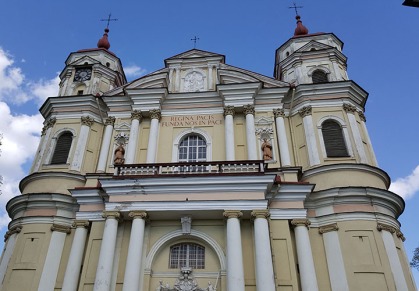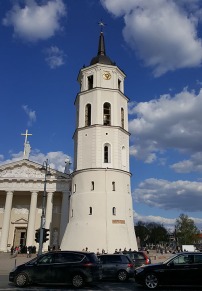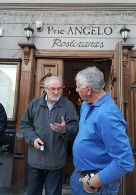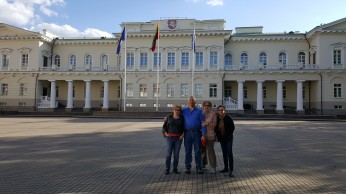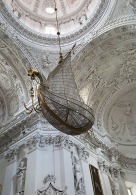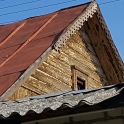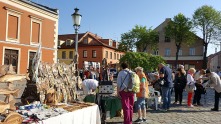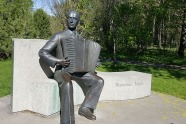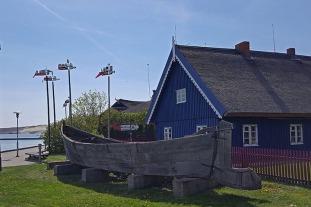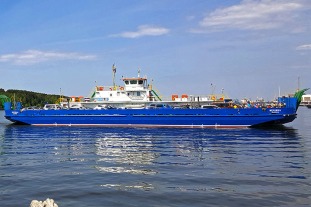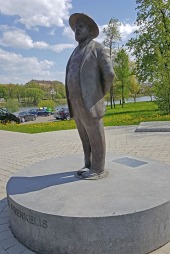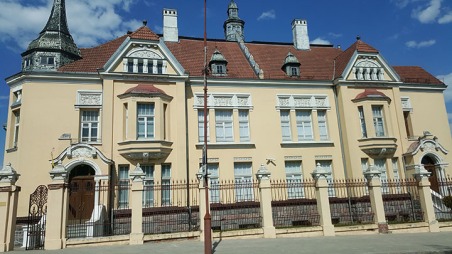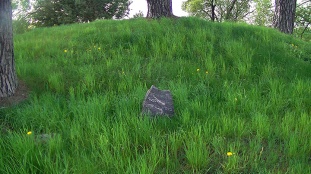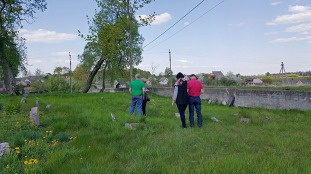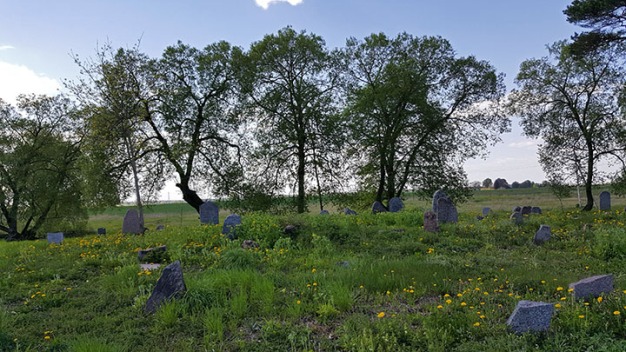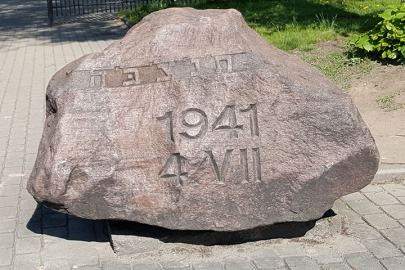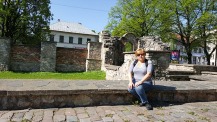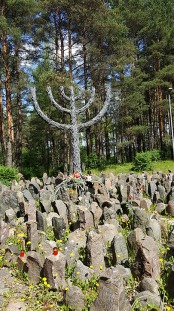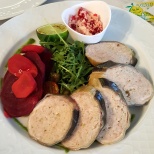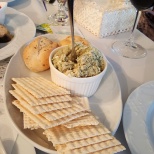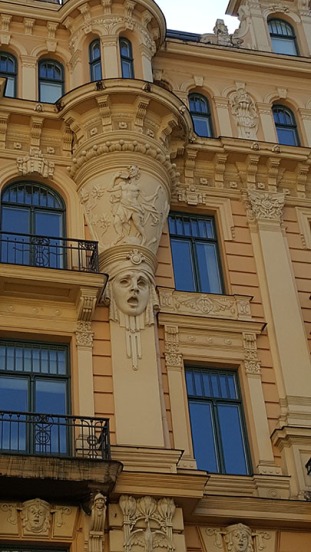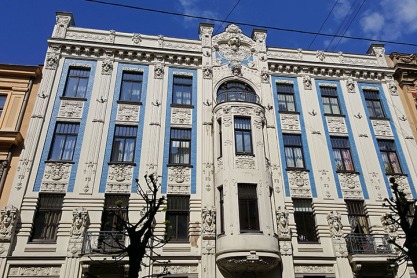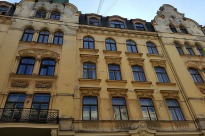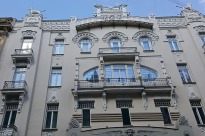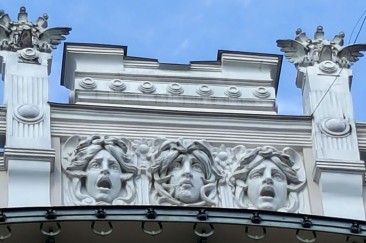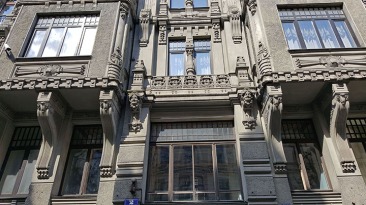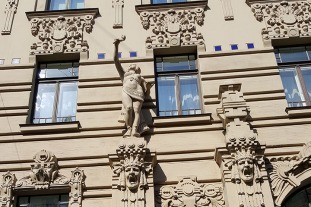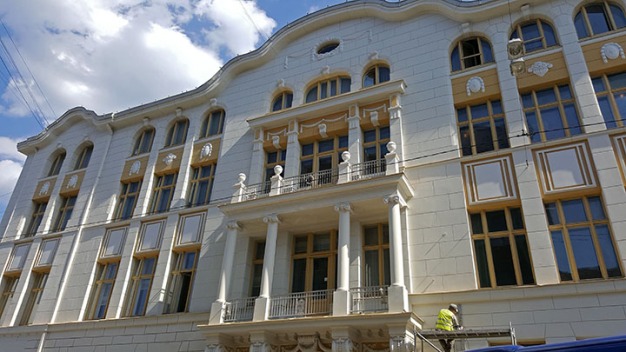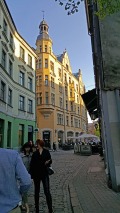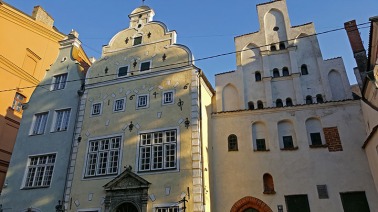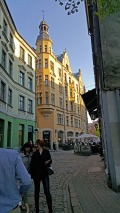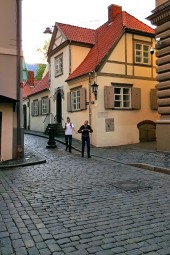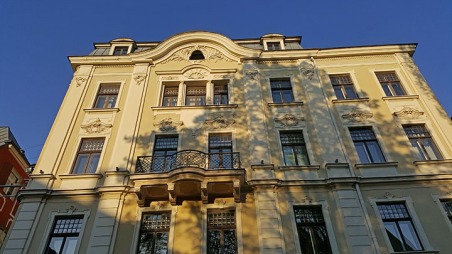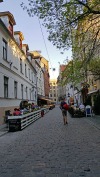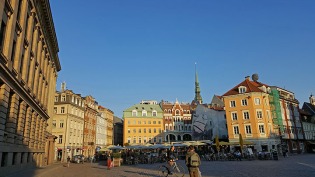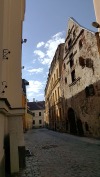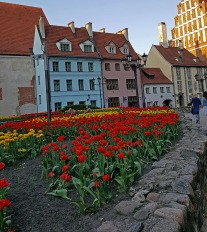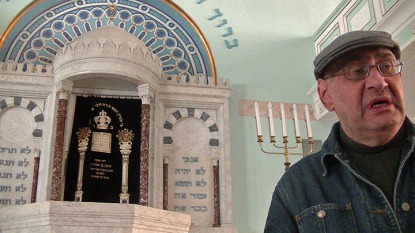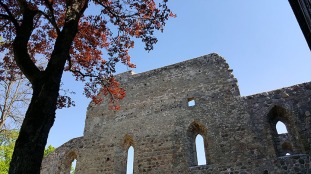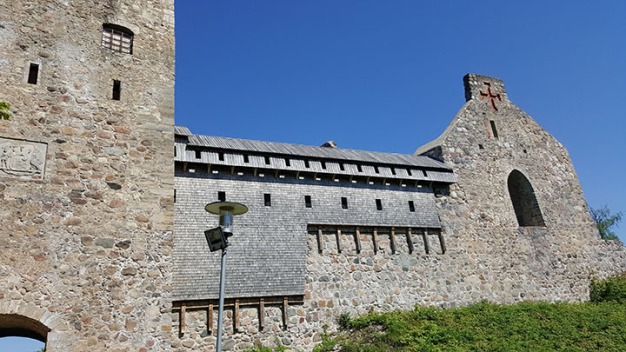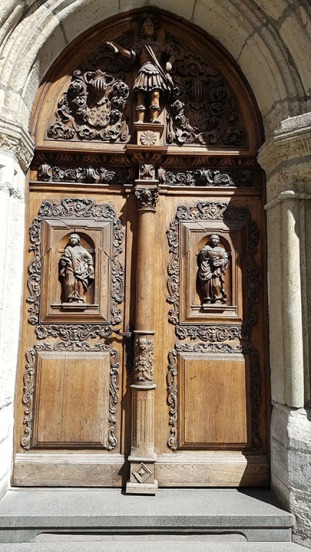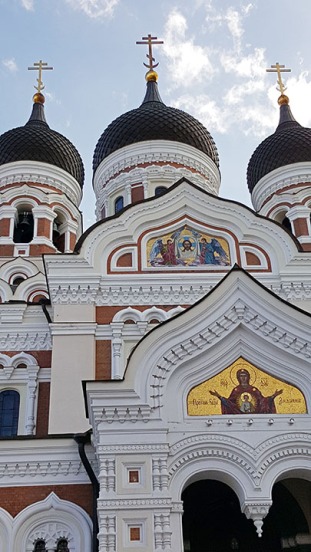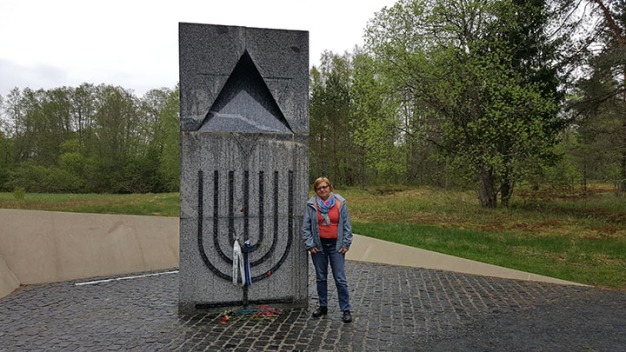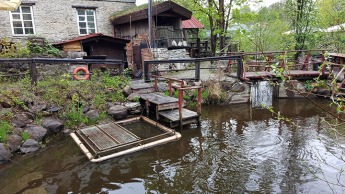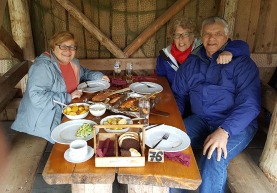Baltics Trip Report
May 2016, Lithuania, Latvia, Estonia
This May I took a group of travel agents with me to the Baltics. Some of them had traveled with me previously and enjoyed our intimate, like-minded group and in-depth experience-focused travel. They encouraged me to form a kind of “Facebook-based travel club,” so they could easily find out about future FAMS and share their experiences together online. Thus, the Baltics trip, which explored the region’s history, Jewish Heritage, cuisine and culture, became the first official “Schleppers Club” trip.
Our trip started in Lithuania’s capital, Vilnius. To get there, I first flew Lufthansa non-stop from Tampa, Florida to Frankfurt, Germany. I took advantage of the German flag carrier’s amazing lounge and made a pilgrimage to my favorite airport bakery, Heberers (https://www.yelp.com/biz/heberers-traditional-bakery-frankfurt-am-main-3), where the authentic pretzels are baked on premises.
Day 1: May 5, Frankfurt – Vilnius
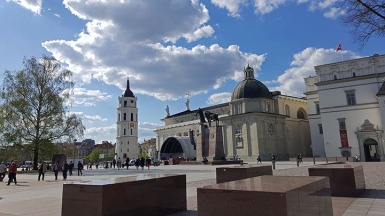
After my Frankfurt connection, I arrived in Vilnius late in the evening and checked into the hotel Radisson Astorija. Set in a landmarked building, dating back to the 15th Century, the hotel was a perfect fit for our historically themed tour in an ideal location in the city center. The hotel echoed with memories of its distinguished past travelers: Prince Charles, King Juan Carlos of Spain, King King Carl XVI Gustav of Sweden, Angela Merkel, George W Bush. The list goes on. You get the picture. My room was a standard room, very small, probably not where the celebrities stayed, but it was nice and comfortable. I got a good night’s sleep, and the next morning after breakfast, I walked a little bit outside to get familiar with the surroundings.
In the afternoon, I met up with the group and our guide, Daniel, for a sightseeing tour of the city.
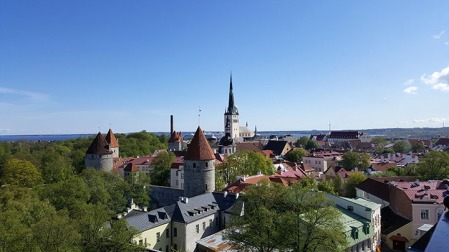 We saw magnificent panoramic city views, as we walked to the Presidential Palace, St. Anne’s and St. Peter and St. Paul’s Churches, City Hall Square and the “Gate of Dawn.” I especially admired the exquisite baroque Peter and Paul’s Church. Behind its plain façade, there is beautiful interior painted in white. It is known for its wooden figure of Christ, with ancient human hair. There is also a decorative, chandelier in form of ship made of brass and glass beads.
We saw magnificent panoramic city views, as we walked to the Presidential Palace, St. Anne’s and St. Peter and St. Paul’s Churches, City Hall Square and the “Gate of Dawn.” I especially admired the exquisite baroque Peter and Paul’s Church. Behind its plain façade, there is beautiful interior painted in white. It is known for its wooden figure of Christ, with ancient human hair. There is also a decorative, chandelier in form of ship made of brass and glass beads.
The town was pleasant, relaxed, and uncrowded. The weather was mild, making touring even more pleasant. Apple and cherry trees were blossoming, but chestnut and lilac, which I was looking forward to, had not opened yet. We strolled through the district and stopped at chocolate shop. We tasted ice cream, and I also bought at hot chocolate. Unlike what we are used to in the United States, this was not a powdered hot cocoa drink. It was not even like my hot cocoa, which I make from scratch with cocoa and milk. This was just melted, liquid chocolate! I drank it with glass of water, so that I would dilute in my stomach. It was incredibly, sinfully rich and delicious!

We also explored the artists’ quarter where, just like in Odessa Ukraine, where I used to live, they have an April 1st celebration. However, in Vilnius on this day in 1997, six years after the collapse of the former Soviet Union, they did something unusual. As a joke that became widespread, the artists of Vilnius declared their neighborhood the
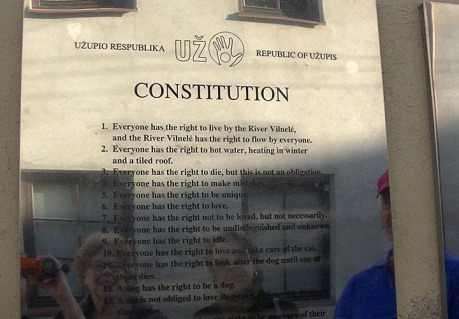 “Republic of Užupis” (http://uzhupisembassy.eu/), meaning “Other Side of the River.” This new republic has its own flag, currency, president, cabinet of ministers, army (numbering 11 men), national anthem, and a constitution! This governing document was written by the poet/musician, Romas Lileikis and the artist/writer, Thomas Chepaitis.
“Republic of Užupis” (http://uzhupisembassy.eu/), meaning “Other Side of the River.” This new republic has its own flag, currency, president, cabinet of ministers, army (numbering 11 men), national anthem, and a constitution! This governing document was written by the poet/musician, Romas Lileikis and the artist/writer, Thomas Chepaitis.
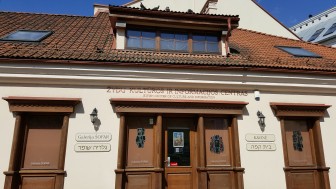
Before the war, this area was site of the Jewish quarter. After the war, it was empty and haunted by its sad history. Then, as time went on, artists and Bohemians moved in. Today, the atmosphere reminds me somewhat of Monmartre in Paris, with its creative population and interesting artistic murals.
It may not be a coincidence that April 1st is also April Fool’s Day! We had fun. We ended the evening with a nice dinner in one of the local “Uzupis” restaurants, where we indulged in roasted duck leg, potatoes and an apple strudel desert.
Day 2: May 6, Vilnius
This day was dedicated to Jewish history in Vilnius. Jews lived in Lithuania from the 12th Century. Jews came from the Grand Dutchy of Lithuania and from Germany; they were called “Litvak.” Vilnius or Vilna, as it was called at the time, was the “Jerusalem of Lithuania. “ Jews were very important contributors to Lithuanian life. As for religion, in 16thCentury, The Great Vilna Gaon (sage), Rabbi Eliyahu, was probably the most influential and spiritual Jewish leader, possibly of all of Europe. We visited his memorial. Here is some information on Vilna Gaon. http://www.myjewishlearning.com/article/vilna-gaon/
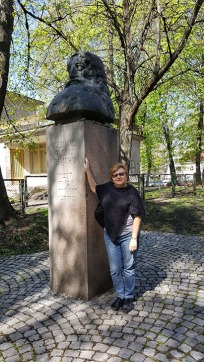 Through the centuries, the region’s Jewish communities survived extensive turmoil and upheaval. In fact, just before World War II, there were 240,000 Lithuanian Jews. However, after the Nazi’s only 5% survived.
Through the centuries, the region’s Jewish communities survived extensive turmoil and upheaval. In fact, just before World War II, there were 240,000 Lithuanian Jews. However, after the Nazi’s only 5% survived.
We visited “Lithuanian Jerusalem,” the medieval Jewish Quarter. Here we saw historic ORT school building; the famous Tarbut Gimnazia, which is now the JCC; the former Yiddish theatre; and the Rabbis’ Council, which hosted Theodor Hertzel’s visit to Vilnius in 1903. We walked the lanes and courtyards, learning of the historic and the melancholy fate of the Great Vilna Synagogue. We also went to Ponar forest to visit a memorial site to the murder of Lithuanian Jews.
We took a break to visit Vilnius’ huge market. We sampled fresh and authentic food, delicious: breads, pickled cucumbers, pickled cabbage, cheese, and sausages.
Dinner was on our own. We found a nice Jewish restaurant, Felice http://www.felicie.lt/
There was a menu of local Jewish (not kosher) and international cuisine. We tried chopped herring “Forshmak,” gefilte fish, borsch, and apple strudel for desert. The décor was “Jewish,” and a local musician played klezmer music. We really enjoyed it, and to our pleasure, it was still light out at 8pm when we finished dinner.
Day 3: May 7, Vilnius – Trakai – Kaunas
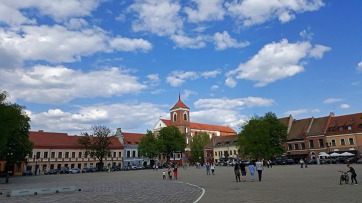 After breakfast, we checked out of the hotel and departed for Kaunas. Our first stop was Trakai. This city was both the ancient capital and the residence of the Grand Dukes of Lithuania. Its 14th Century insular castle is located on a stunningly picturesque island, surrounded by lakes.
After breakfast, we checked out of the hotel and departed for Kaunas. Our first stop was Trakai. This city was both the ancient capital and the residence of the Grand Dukes of Lithuania. Its 14th Century insular castle is located on a stunningly picturesque island, surrounded by lakes.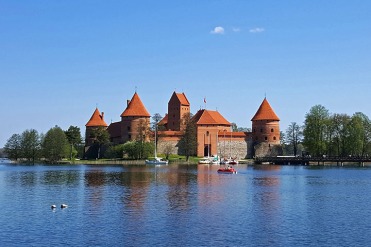
There, we visited the Museum of Lithuanian History, showcasing the life of different estates and ethnic groups. A very interesting discovery was about the Karaims. They were a small ethnic group that confessed Judaism and was brought here from Crimea by Vytautas the Great 600 years ago.
The Karaim religion called “Karaism,” has faith in the Old Testament, whose dogmas are built upon the truth written in Bible. They do does not accept any authoritative comments on the holy texts – neither orally nor in writing. None of the other Scriptures – in the New Testament, the Talmud, or the Koran are holy or codified in the system of the Karaism. That is, they do not provide arguments and they do not reflect upon the tradition (oral or written) in the interpretation of religious matters. All authentic truth is hidden only in the Old Testament, and every Karaim believer has the right to look for it in the text  himself. The name of the religion itself (Karaism) reflects its meaning. It derives from the word ”kara,” which in Arabic and Hebrew languages means “to read,” as in the right to recite the Holy Writ.” The most famous and widely spread theory about the formation of the Karaism doctrine says that it started in Mesopotamia in the VIII Century, under the dynasty of a caliph Abu-Jafar-Abdullah al-Mansur, who governed in 754-775. The idea of opposing the existing rabbinical tradition of commenting on the Old Testament and its observance came to Anan, the son of David.
himself. The name of the religion itself (Karaism) reflects its meaning. It derives from the word ”kara,” which in Arabic and Hebrew languages means “to read,” as in the right to recite the Holy Writ.” The most famous and widely spread theory about the formation of the Karaism doctrine says that it started in Mesopotamia in the VIII Century, under the dynasty of a caliph Abu-Jafar-Abdullah al-Mansur, who governed in 754-775. The idea of opposing the existing rabbinical tradition of commenting on the Old Testament and its observance came to Anan, the son of David.
We had lunch in a Karaite’s restaurant, Kyblynar (http://www.kybynlar.lt/) , where we had their traditional savory pastries with meat and vegetarian fillings.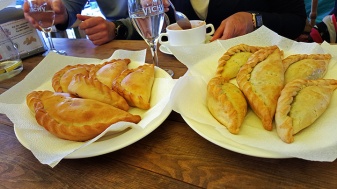
After lunch, we were on the way to our next destination – Kaunas. Formerly called Kovno, it is second largest Lithuanian city, and was briefly the capital of Lithuania in 1920. We enjoyed a panoramic view of the city, which is surrounded on three sides by rivers. The medieval Old Town of Kaunas is located next to the confluence of two major rivers: Neris and Nemunas. This confluence, once important for trade, is still guarded by the tower of Kaunas castle, which dates back to 14th Century. We walked to the City Hall square, marked by a tall tower, where we saw quite a few celebrations, especially weddings.
We meandered further on the pedestrian area and shopped for amber and other souvenirs. Then, we arrived at the Beer House, Apynys. Here, we had beer tasting, toured the brewery, and had nice dinner paired with a variety of beers and other libations. Attached was a small museum, where we also saw the smallest beer glass (miniature) in the world.
We spent the night at hotel Daugirdas.
Day 4: May 8, Kaunas – Cironian Spit – Klaipeda.
In the morning, we checked out from the hotel, and went on to see more Jewish sites.
The former area where Jews lived, Slobodka, is now a suburb of Kaunas. Jews lived there since the 15th Century. In 1941, when the Nazis came in, out of 30,000 only 6,000 Jewish stayed there, all rounded up in the Kovno ghetto. Later on, other Jews were brought into the ghetto, and all of them were killed at the Ninth Fort. There is now a Ninth Fort Museum (www.muziejai.lt/kaunas/forto_muziejus.en.htm) dedicated to the Holocaust and Soviet Genocides. We visited the current synagogue, and the Ninth Fort Memorial, the site where the killing took place. It was a very solemn and emotional site.
In Slobodka, wooden and some brick houses looked like just like they were 3-D shtetle photos. For some reason, we felt compelled to look behind fences and imagine what life was like before the war. The current tenants came out of the houses and the dogs started barking. It was 9am on Saturday. They did not talk to us, just looked. They are probably used to Jewish tourists coming there. Or, maybe they were concerned that we had come to claim property?
Speaking about property, after their Soviet independence, the Baltic countries passed restitution laws. These laws entitle those owners of property and land, before 1940, to get it back. This needs to be settled with the current owners, and sometimes the court is involved.
It was time to leave Kaunas, and we continued to the Curonian Spit.
The Baltic Sea coast of Lithuania, an area stretching almost exactly 100 km (62 miles) and featuring the three fascinatingly different settlements of Klaipėda, Nida and Palanga, offers visitors to the western perimeter of the country an extreme diversity of options.
The remarkable Curonian Spit runs along the southeastern coastline of the Baltic Sea. The spit, divided between Lithuania and Russia’s Kaliningrad province, extends south from the Lithuanian seaport of Klaipėda. It’s a fragile, peaceful ecosystem of pine groves and sand dunes that offers something for everyone. Pristine sand beaches attract sunbathers during Lithuania’s short summer season.
Home to a busy port and two waterside resorts that couldn’t be more different than each other if they tried, the region has witnessed the kind of historical turbulence usually only encountered in novels. Since the re-establishment of Lithuanian independence exactly 25 years ago, this region has grown into a serious vacation destination that, once discovered, isn’t easily forgotten.
As we entered the Spit, we passed through a National park. Then, we took a five-minute ferry ride, while sitting in our vehicle. Once on another side, we drove along a picturesque road between pine forests, until we stopped at Juodkrantė. This resort town, with a permanent population of only 720 people, is a quiet Lithuanian seaside village, located on the Curonian Spit. A part of the Neringa municipality, Juodkrantė is the second largest settlement on Lithuania’s side of the Spit.
The specialty of the region is fish, of course; so for lunch we enjoyed a variety of fresh, delicious, smoked-on-the spot fish in a relaxing restaurant along the water. Fishing has always been more than just business on the Curonian Spit. It is a way of life, and hence the main dish is fish!
We also walked through a lovely park in the pine forest to the Hill of Witches, a vivid example of Lithuanian folk wooden sculptures.
We continued to Klaipeda, known historically as Memel. Located on the Baltic Sea coast, it is the third largest city in Lithuania and the capital of Klaipėda County. The city has a complex recorded history, partially due to the combined regional importance of the usually ice-free Port of Klaipėda at the mouth of the Akmena-Danė River. It was controlled by successive German states until the 1919 Treaty of Versailles. As a result of the 1923 Klaipėda Revolt, it was added to Lithuania and has remained a part of Lithuania to this day, except for the period between 1939 and 1945, when it returned to the Third Reich following the 1939 German ultimatum to Lithuania.
The architecture of Klaipeda, unlike previous towns we’ve seen in Lithuania, is Hanseatic. Most of the population is German.
We checked into our hotel, Amberton Klaipeda. It is a Four-Star high rise in the center of town overlooking the port, with very pleasant views. We were upgraded to Seaview rooms, on higher floors. Unfortunately, this also meant direct sun exposure. It was hot that day and our rooms were hot even with air conditioning! We discussed this with the reception, and they moved us to the Fourth Floor with better temperatures but no views, but it was fine for one day. The staff was amazingly accommodating. They moved our bags and made sure we re-resettled comfortably.
Day 5: May 9, Klaipeda – Riga
The next morning, it was Sunday. We checked out from hotel and went to the Sunday market. There were displays of wool, silk, cotton, wood and amber souvenirs and clothes. We continued to our next destination, Riga, the capital of Latvia.
First we went to Siauliai where we learned about Chaim Frenkel.
Like Poznansky in Lodz, Chaim Frenkel was an industrialist and philanthropist in Lithuania. In the late 19th century, he opened one of the largest and most modern leather processing plants and footwear factories in then Tsarist Russia, in the city of Siauliai. We even saw his villa from the outside.
The Chaim Frenkel Villa is a building of the modern epoch of architecture. His family lived there, and then from 1931 to 1935 it was a Jewish secondary school. During and after the war it became a military hospital. In 1994 it was sold to the Šiauliai Museum. It is a beautiful building. Nearby there was a bronze statue of Chaim Frenkel himself. This video shows the dedication ceremony for the statue: https://www.youtube.com/watch?v=UtOK_JZ3Hiw.
We continued to the Hill of Crosses, a symbol of the Lithuanians’ resistance against

foreign rule, with its over half-million crosses. Between crosses, there is one Jewish star.
After the Hill of Crosses, we stopped in the small town of Zagare (Zhager), following heritage routes. It is a quiet town that had once been well known for its famous scholars, writers and rabbis, but most of them were murdered in Holocaust. Recently, only one Jew lived in Zagare, but he died a few years ago. We looked at the abandoned old Jewish cemetery. We also saw a former synagogue complex, where a gym stands now.
We had lunch in a “truck stop” restaurant called Smakas, which had alcohol detection 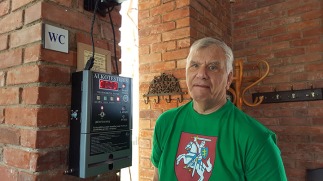 machine J . Lunch was very good, with white cloth service! I especially liked the cold beet soup based on kefir.
machine J . Lunch was very good, with white cloth service! I especially liked the cold beet soup based on kefir.
We continued to Riga, and although we arrived in the evening, it was still light out. We checked into our hotel, the Grand Palace Riga, right in the Old town. We bid farewell to our guide Daniel. In about 30 minutes we were ready to see Old Riga with local guide and travel agent, Armands.
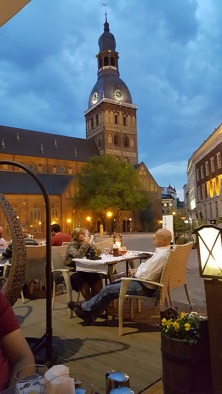
Riga, dating back to 13th Century, was beautiful. In the Middle Ages it was a major center of the Hanseatic League and quite prosperous, which is shown through some pristinely restored buildings. In the 19thCentury, there were also built some neoclassical buildings. And, it has the fine collection of Art Noveau (Jugendstil) architecture. We enjoyed a mix of medieval houses, gothic roofs and some Renaissance.
We walked the center towards our next eating venue – restairant Pi Kristapa http://piekristapa.lv/ .
On the way we passed Lutheran and Catholic churches some of them built in the 13th c. , in Dome Cathedral; the Great and the Small Guilds houses of Riga, the Swedish gate, the Cats’s house, the “Three Brothers”- the oldest constructions of Riga, the House of the “Blackheads”, St. Peter church.
We decided that we were too tired after long day and caught a taxi to the restaurant, where we had a nice dinner.
Day 6: May 10, Riga
We loved our hotel. In the breakfast room, there was a parrot named Misha. He understood English but for some reason only talked to men!
After breakfast, we met our guide Victoria and proceeded to the synagogue. Riga’s synagogue is gorgeous. It is well lit, immaculately restored in pale pastel colors, and decorated with blue ornaments. The décor features and ancient Egyptian theme. It is one of the most admired Art Noveau Buildings in Riga (Jugendstihl).
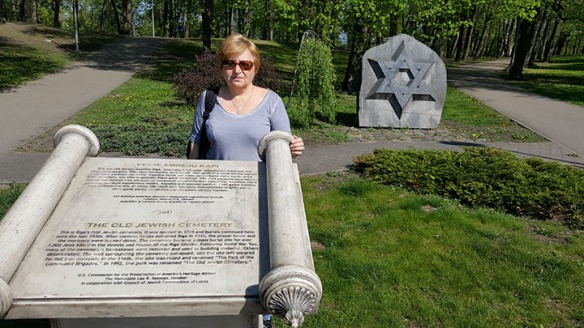
We had a conversation with a synagogue representative, who has been a member for two generations. His father founded a matzoh factory for refusniks. The refusniks were people (mostly Jews), who during Soviet times, petitioned to leave the country but were refused. I am one of them… We lost our jobs and means for a living. This synagogue provided work to refusniks, such as making matzoh. Today it is home to, not a large but very active Jewish community.
Before the war, the Jewish community was very prosperous. There was no ghetto until the Nazis came.
After this synagogue, we went to see the site of the burnt synagogue, and former Nazi-era
ghetto, now a memorial. We went to Salaspils memorial, a former concentration camp site. There were some “heart beat sounds” at memorial – a kind of continual boom, boom, boom sound, like a metronome. This gave us a chill. It was a very powerful and sad site.
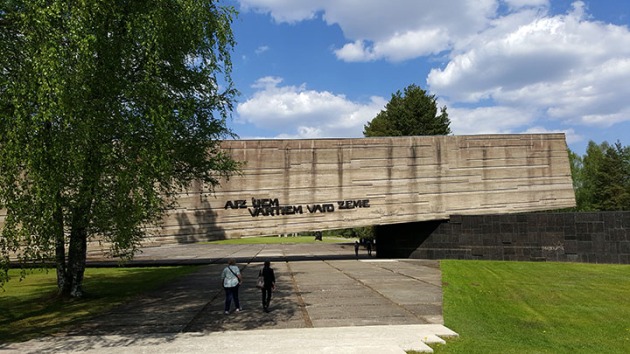 In the nearby Rumbula forest, was a small “klling field.” This was actually a small
In the nearby Rumbula forest, was a small “klling field.” This was actually a small
clearing within the forest where about 25,000 Jews were murdered in two days: 30 November and 8 December 1941. Today, it is part of the Riga suburbs. The site was maintained as a memorial during the Soviet period, and the large mass graves were kept visible, but in 2002, the site was redesigned and memorials specifically commemorating Jews were added. (The Soviets avoided the word Jews and only called the victims “Soviet citizens”).
After the memorial sites, we proceeded to the Jewish community center. It was a pleasant, uplifting change to see the current Jewish community. Besides the beautiful synagogue, there is also a Jewish school. The city provided and restored the building, but there are still issues of returning property that belonged to Jewish organizations before 1940.
We also visited the Jewish museum, where the rich centuries’-old Latvian Jewish history is presented, along with Holocaust history and afterwards.
We had lunch in a café at the Jewish community center with homemade cooked Jewish
food (not kosher) at a reasonable price. We talked with an elderly couple who came to get their meals, and they looked like my grandparents.
After lunch, we went to Albertus Street to see some more amazing buildings in the Jugendstihl Art Novaeu style. Everyone knows and admires Barcelona architect Antoni Gaudi. He created his own, unique, bio-morphic, modernist Art Novaeu style, without symmetry or right angles. However, although little known, the city of Riga’s modernist quarter gives Barcelona some heavy competition. These buildings created by Russian architect Mikhail Eisenstein are even on the UNESCO World Heritage list. We stood with amazement looking at Eisenstein’s quirky and emotionally charged building style – carved stone faces with intense expressions almost cry out. For these alone, tourists flock to Riga. One interesting point is that he was not a professional architect. It was his hobby, but Mikhail Eisenstein was very talented. So was his son Sergei who was a director of film Battleship Potemkin. For those interested in architecture, Riga must be on top of your destination list!
At the end of the day we went to seaside resort of Jurmala.
On the way we visited the Janis Lipke Memorial Museum, dedicated to this brave man who hid and saved 50 Jews. The architecture was very interesting. It is kind of claustrophobic, but it was designed this way to show the feelings that people experienced in the bunker with little daylight. It did not help that we came at the end of the day and the director of museum let us in, so we were alone and at the end could not get out! Eventually they came and opened exit door. In any case, it is a very interesting museum and memorial, and I recommend it as a part of any Riga visit to remember the Holocaust and the “Righteous Among the Nations.”
It was a pleasant change to come to Jurmala and enjoy some lovely time on the seaside promenade. The pristine beach beckoned, but it was too cold to swim. I liked the architecturally interesting 19th and early 20th Century wooden houses, some of them mansions. The town claims an official list of 414 historical buildings under protection, as well as over 4,000 wooden structures.
On the promenade, we found Dzintari Concert Hall, where for many years, every summer numerous festivals took place. Most featured Russian music and comedy club performances. Very popular was “New Wave,” a contest for young popular music performers. It was founded by Latvian pianist and composer Raymonds Pauls and enhanced by a very famous Russian superstar Alla Pugacheva. New Wave used to be held here, but due to difficult Latvian-Russian relations, the contest was moved to Sochi. Summer was always busy in this seaside town, but what will become if it now, remains to be seen. The guide did tell us that Jurmala is still a popular destination. I could understand that. We strolled down lovely Jomas street, with its outdoor restaurants and shops, went to the beach and then back to find our driver and return to Riga. It was long day, so back to in Riga, we had a relaxing dinner near the hotel in a nice, local restaurant Key to Riga. It was somewhat touristy, with a very long menu but very good service. Of note, there were some unusual “Classic Latvian dishes” on the menu, such as Bull Testicles. We passed on that.
Day 7: May 11, Riga – Sigulda – Pjarnu – Tallinn
We checked out from the hotel and departed for Tallinn. On the way, our guide Armands took us to Sigulda.
Due to its hilly location, Sigulda is referred to as the Latvian Switzerland. Located on the banks of the River Gauja, it is an excellent place for outdoor activities and enjoying the area’s beauty. It was founded around the 11th Century by Finno-Ugric tribes, Livonians – the indigenous peoples of Latvia.
Sigulda Medieval Castle was built by the Livonian Brothers of the Sword founded in 1202. Officially, they were called The “Militia of Chirst of Livonia.” Mostly these warriors were German monks, who later became Livonian Brothers of the Sword. It was the first order formed outside of the Mediterranean region. They protected Livonia land and went on crusades to conquer new territories.
Later, in 1878, on the same location where the castle stands, the New Castle of Sigulda was built in the Neo-Gothic style, as the living house for the owners of the manor.
During the winter season, the ski slopes and bobsleigh track host international competitions. In summer, the options are boating down the River Gauja, biking and mountain hiking.
Also, this area is famous for the most Latvian holidays of all – Jani or “Liigo!” (Next year, we will be going there, please inquire!) At night, from June 23 to June 24, in harmony with the summer solstice, people participate in the joyous festivities, as their ancestors did centuries ago. On the longest day and shortest night of the year, Latvians make garlands, drink beer, eat caraway cheese, sing, dance, and go to the sauna, all up until dawn!
We left Sigulda continued North and crossed the border to Estonia.
On the way we passed Baron Munghausen’s birth place, which is now a museum. There is also a statue of him on the road. He was a fictional German nobleman, created by the German writer Rudolf Erich Raspe in his 1785 book Baron Munchausen’s Narrative of his Marvelous Travels and Campaigns in Russia. I’m not sure if this is popular in USA, but his fantasy stories used to be my favorite book!
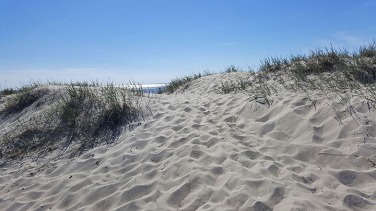 We stopped in one Hedon Spa (http://www.hedonspa.com/en/) at the nice seaside resort of Pjarnu for lunch. I liked it’s modern, Scandinavian atmosphere. The kitchen featured Nordic cuisine. We sampled various grilled meats with potatoes and vegetables. Meat was excellently grilled. Afterwards, we walked the dunes, and visited the monument of Estonian composer Raimond Valgre, where his melodious music was playing.
We stopped in one Hedon Spa (http://www.hedonspa.com/en/) at the nice seaside resort of Pjarnu for lunch. I liked it’s modern, Scandinavian atmosphere. The kitchen featured Nordic cuisine. We sampled various grilled meats with potatoes and vegetables. Meat was excellently grilled. Afterwards, we walked the dunes, and visited the monument of Estonian composer Raimond Valgre, where his melodious music was playing.
From Pjarnu it took about 2 hours until we reached Tallinn, and it was late afternoon when we arrived and said goodbye to Armands and the driver.
We checked into hotel St. Petersbourg, a small boutique hotel, which is rated 5*. There is probably only one feature that I think made it not qualify for 5*-status, and that is its lack of an elevator. During our stay, the hotel had a few maintenance issues, but they were all resolved quickly and the staff compensated for some deficiencies of this old building with their excellent service. For example, when maintenance issues came up, they immediately relocated my travel mates to better rooms. I had some leakage on top floor and they fixed it quickly and sent me a plate with fruit and pastries for the inconvenience. (The inconvenience for me was that the leak was directly above toilet seat! You can picture it. J)
My guide in Tallin, Ljuba, with whom I’ve been working for many years, came for dinner. She is a very enthusiastic and active member of the Jewish community. Since the Hotel St. Petersbourg has a Russian restaurant, we had a tasting meal of various Russian specialties. I translated and explained the dishes. Everyone enjoyed it. Especially, the Beef Stroganoff was excellent.
Day 8: May 12, Tallinn
The next morning, we met Ljuba and went to explore the Old town. Many people come to Tallinn on cruise ships. They report to me that they are sorry they have so little time. It deserves at least 2-3 days. Tallinn (formerly Revel) is the capital of the Baltic state of Estonia. Tallinn is the most northern Hanseatic city. Being a fortress city, it has never been conquered. One third of the state’s population lives in this seaport town, and 4 million tourists vacation here each year.
The “Old Town” section of Tallinn is beautiful, compact, and medieval. It was a member of the Hanseatic League, and you can see Hanseatic influence in architecture, which also reflects its prosperous trading history with Northern merchants. Merchants were Danish and German. Russians also had major influence in Tallin, and they built the beautiful Alexander Nevsky cathedral. We looked at town hall, which is the only surviving gothic town hall in Northern Europe. The small cobblestone streets, with cozy restaurants and quaint shops looked so inviting; so even though we were not hungry, we stopped at café for coffee and pastries.
Later, we took taxis to the Jewish community center.
Jewish history of Tallin:
Jews had lived in Tallin since the middle ages. The first members of the Jewish community were Cantonist. These were Jewish boys who were taken by the Tsar’s Army at a very young age (as early as 8-12). They had to serve in the army for 25 years under very harsh 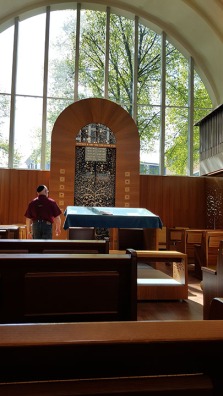 conditions, where they were also encouraged to convert to Christianity. Those who survived were given better “benefits” compared to other Jews and were allowed to settle in some places where regular Jews could not. As a result, you can see that descendants of Cantonists settled in some places outside of the Pale of Settlement. Such an example of these settlers is in both Estonia and Finland. Cantonists opened their synagogue in the 19th Century. So it is a relatively young community compared with Latvia and Lithuania. Unfortunately, during WWII, Estonia became 100% “Judenfrei.” Everyone who stayed was murdered. The Synagogue was bombed. The only Jews who survived were the ones who evacuated with the Soviets after the Soviet occupation in 1940. After the war, some Russian Jews moved to Estonia because it had less anti-semitism than other republics. In general, the story of Estonian Jews is very similar to those from Latvia and Lithuania.
conditions, where they were also encouraged to convert to Christianity. Those who survived were given better “benefits” compared to other Jews and were allowed to settle in some places where regular Jews could not. As a result, you can see that descendants of Cantonists settled in some places outside of the Pale of Settlement. Such an example of these settlers is in both Estonia and Finland. Cantonists opened their synagogue in the 19th Century. So it is a relatively young community compared with Latvia and Lithuania. Unfortunately, during WWII, Estonia became 100% “Judenfrei.” Everyone who stayed was murdered. The Synagogue was bombed. The only Jews who survived were the ones who evacuated with the Soviets after the Soviet occupation in 1940. After the war, some Russian Jews moved to Estonia because it had less anti-semitism than other republics. In general, the story of Estonian Jews is very similar to those from Latvia and Lithuania.
The synagogue, which was built in 1883, was destroyed by bombing during World War II. After the war, the Soviets did not encourage religion. So, Jews gathered in separate prayer houses. In reality, Estonia never felt fully Soviet compared to Russia, Ukraine, “the Stans,” etc. They had a much better quality of life and living.
The Soviet rule ended in 1991. Since then, it has been an independent country with an active Jewish community. Jews were able to start living open Jewish life again. In 2000, they built a new synagogue, which features many symbolic references. Now the center of Jewish life, this secure building also houses a Jewish school and community center. In addition to hosting religious services and Jewish holiday celebrations in the main hall, the Synagogue oversees the preparation and distribution of kosher food. There is also a Mikvah and a Jewish museum. “A Synagogue is an integral part of Jewish life. It is good not only for Jews, but for all residents of our multi-ethnic Estonia,” affirmed the Chief Rabbi of Estonia, Shmuel Kot.
Special permission is needed to enter and they buzz guests in. Travelers cannot just drop in. The synagogue building was modern and light. We met with president of the synagogue, who told us about its history and current life. It is a small but very tight, close and thriving community. They take care of their security by themselves by training their members in Israel for security. They have close ties with Israel.
While in the synagogue, we met quite a big French delegation, whom we were told, are descendants of French Jews deported from France, kept in a Klooga labor camp nearby and barely survived executive. Only a few escaped and returned to France. One member of the synagogue took upon himself the task to document and find his relatives. In 2007, a monument was opened to commemorate this, and every year a group of their descendants come to Tallinn. So this was the group we met.
An interesting Jewish museum contained documents about the history of the Jews from the 12th Century until the present day. I saw modern documents from the 1970s, including an exit visa for people emigrating from the Soviet Union, the same as I had! Ljuba proudly showed us photos of the community in the museum, including her own children. So these people are making history and preserving it for the next generation.
After the tour of the JCC, we took taxis back to town and said goodbye to Ljuba.
We strolled the town and had medieval feast, which I reserved in advance, in a famous 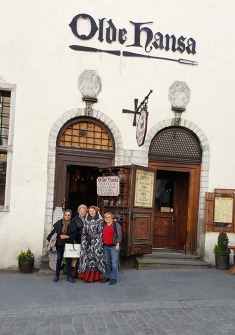 restaurant “Olde Hansa.” It was an experience http://www.oldehansa.ee/en/
restaurant “Olde Hansa.” It was an experience http://www.oldehansa.ee/en/
We tried most medieval dishes and local wine and had a lovely conversation with a costumed waitress. “Can you taste if the food is not poisoned?” Then others continue to eat 🙂
After a long meal, we enjoyed the Old Town a bit more and retired to the hotel early.
Day 9: May 13, Tallinn
The next day, we met my colleague in Tallinn, Dmitry who took us to see “his Tallin” by car.
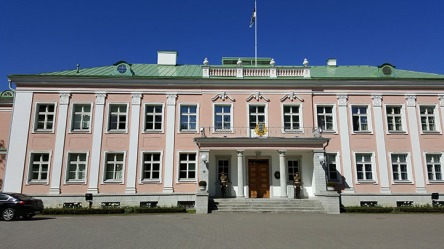
We saw beautiful Cardiorg Park, with Cardiorg Palace, built by Peter the Great in the Baroque style. While comparatively smaller scale, compared with Russian palaces, it still showcases the grandeur and extravagance of the Russian tsars. Like the Russian palaces, it was built by an Italian architect. A highlight is the pleasing and beautifully manicured gardens. Nearby is an art museum, which we did not have time to visit.
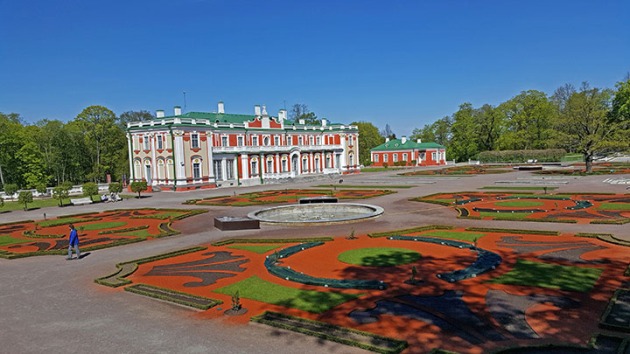
After the Park, we saw a Rusalka monument, commemorating the Russian warship Rusalka (Mermaid), which was shipwrecked in 1893. It shows a beautiful angel holding a cross pointing toward the sea.
Next, we went to the memorial site of Klooga, a former concentration camp: https://en.wikipedia.org/wiki/Klooga_concentration_camp, and visited the memorial there. As with Latvia and Estonia, the sad fate was repeated there and after the war, the Soviets did not recognize Jews as victims but only “Soviet Citizens.” Only after independence, was Estonia able to erect a commemoration monument to the Jews.
Day 10: May 14, Tallin and the countryside
This was our last day in Estonia, and we dedicated to enjoy the countryside.
Driving out of Tallinn to the northwest we enjoyed a view of the Baltic Sea from a 40 meter high cliff called Rannamoisa or the Hamlet’s cliff. You can see Finland from there, but the weather did not cooperate with us.
We visited the manor house that belonged to Count von Benkendorf – the founder of the first secret service in the Russian Empire. The manor is built on the high bank of the river, next to one of the most beautiful waterfalls in in Estonia – Keila Joa. We saw waterfalls there.
Next, we went to a town called Paldiski, which is the place where many important events of the 20th century intersect. The town was founded by Peter the Great as a major naval base on the Baltic Sea. However, Paldiski had also been one of the most important training centers for Soviet submarine officers, and many artillery batteries were located here during WWII.
We had lunch at a trout farm, where we ate the most delicious pink trout. We opted not to fish it ourselves. Instead, we watched how other guests did it. It came with well-prepared salad and potatoes.
Day 11: May 15, Tallin – Helsinki
This concluded our tour to the Baltics. The next morning we checked out of our hotel and went to the port, where we took a ferry to Helsinki, Finland.
Some thoughts/issues
On May 9, There were many people wearing St. George’s striped ribbons. These were Russians. They constitute about 40% of population and they were celebrating Russian/ Soviet Victory day. It is a bit of a touchy subject, because for former Soviet Republics it is considered as a Soviet Victory. Although the Nazis got defeated, it marked not just the end of war, but the beginning of the Soviet Occupation. It is the current controversy in most former Soviet Republics, not just the Baltics.
Restitution laws have been passed in all three countries. The laws state that all property and land taken from people since 1940 (the time of Soviet Occupation, 1941 – German Occupation and after 1945 – again Soviet), must be returned to the original owners or descendants. A significant part of this is the return of the property confiscated from Jews and Jewish communities by the Nazis. There were some issues, for example with Baltic Germans who left in 1941 with the Germans. They are considered enemies. But, eventually for example, the Estonian court decided to treat them equally as former Estonian Nationals. The same situation is the case in Latvia with their “riffle man.” I personally still cannot understand why they are considered national heroes, because to me, they are fascists.
Here are some relevant articles:
In Lithuania: http://www.timesofisrael.com/israeli-government-agencies-disagree-on-new-lithuania-holocaust-restitution-plan/
Citizenship.
Upon independence, after 60 years of Soviet occupation, all three countries were left with a mixed population of Russians (and other nationals from the former Soviet Union), Poles and local ethnic citizens (Latvian, Estonian, Lithuanian). All were Soviet citizens previously, and their main language was Russian. The three countries had somewhat different laws regarding how to designate citizenship.
In Lithuania, everyone got automatic citizenship, if they were born within the borders of Lithuania. Language proficiency was not required. Before 2006, it was possible to have dual citizenship but later it was abolished.
In Lativa and Estonia, there was a similar condition to grant citizenship to persons born before 1940 in Latvia. For others, citizenship was only granted through naturalization and with demonstratable language proficiency.
Conclusion.
The Baltic countries are one of the best kept European secrets. They are not Eastern Europe but Northern.
They are still undiscovered by mass tourism, but they are members of the European Union. They offer a variety for different interests to tourists:
*Religious Heritage: Catholic, Pagan, Jewish
*Outstanding architecture: Gothic, Baroque, Neo Classic, and Art Noveau style buildings
*Local crafts and art: Wood carving, granite sculpture, painting, amber, and more
*Most people speak English.
*Gorgeous natural scenery: woods, dunes, dramatic sea-scapes. etc.
*Delicious fresh food and ethnic specialties.
*Clean cities, friendly people.
*Overall: The experience is similar to Scandinavia but much less expensive.
For more photos, see our slideshow:
https://www.youtube.com/watch?v=aspEtA8X4Hs
Copyright: Sophia’s Travel, division of EMCO Travel, LLC
